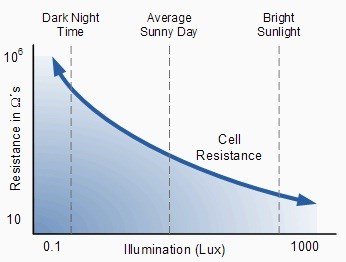What is the Full Form of LDRLDR: Light Dependent ResistorLDR stands for Light Dependent Resistor. LDR is a special kind of resistor. The resistance of the LDR is calculated by the quantity of light which falls on the surface of the LDR. 
LDR is very similar to a potentiometer (potmeter or pot). To change the resistance of the pot, the knob of the pot needs to be rotated, whereas, in the case of LDR, the change of the resistance only depends on the amount and intensity of light falling on its surface. The resistance of the LDR is in indirect proportion to the amount of light falling on its surface, which means that if the amount of light falling on the surface of the LDR is increased, then the resistance of the LDR is decreased and vice versa. LDR can be used in many projects or applications like dark detectors, Automatic Street lights and Motor speed control. How is LDR made?To make an LDR, a semiconductor with very high resistance is used. However, there is no P-N junction. LDR shows all the characteristics of a semiconductor as it is made of semiconductors like cadmium sulfide. The other semiconductors used to make LDR are cadmium selenide, lead selenide, indium antimonide, etc. To make an LDR, the semiconductors are kept in a zigzag position. On both ends of the semiconductors, metal contacts are put, which help make a connection with the LDRs. For the protection of these semiconductors, i.e. photosensitive material, a coating of a transparent material is done. Also, the transparent coating to protect the LDR allows light to pass through and helps in the overall functioning of the LDR. Working of the LDRThe working of the LDR is based on the principle of photoconductivity. When the light falls on the surface of the LDR, the energy of the light is absorbed by it as LDR is made up of photoconductive material, and then because of the energy of the light absorbed, the electrons present in the valence band of the photoconductive material get excited and jump into the covalent band as a result of which the conductivity of the LDR is increased. This effect is the result of an increase in the amount of light that falls on the surface of the LDR. It is essential for the working of the LDR that the energy is absorbed because the light's falling is greater than the bandgap energy so that the electrons present in the Valence band can get excited to reach the conduction band. The resistance of the LDR gets to maximum when it is dark, and it is calculated around 1012 ohms. Also, the resistance of it gets decreases as the intensity of light increases. If we draw the resistance and the intensity (illumination) of the light on a graph, then it will be hyperbolic in nature. 
Types of LDR1. Intrinsic Photoresistor Intrinsic Photoresistors (also known as a Photocell, light-dependent resistor, or photo-conductive cell LDR) are made using pure semiconductors only, and no doping is done while making them. The semiconductors which are used while making this kind of LDR are germanium and silicon. The working of these kinds of LDR is, HOWEVER, the same as other LDRs. When the light with high intensity falls on the surface of the Intrinsic Photoresistor, some of the electrons from the valence band get excited and jump to the conduction band. 2. Extrinsic Photoresistor No pure semiconductors are used for making these kinds of photoresistors, which means that semiconductors are used with some impurities like phosphorus while making it. This kind of extrinsic photoresistor is made for light with long wavelengths. How is LDR tested?
Next TopicFull Form
|
 For Videos Join Our Youtube Channel: Join Now
For Videos Join Our Youtube Channel: Join Now
Feedback
- Send your Feedback to [email protected]
Help Others, Please Share










